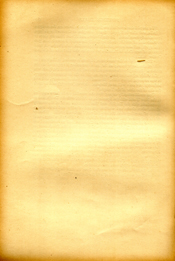PORTABLE SUN-DIALS
BY LEWIS EVANS, F.S.A., F.R.A.S.
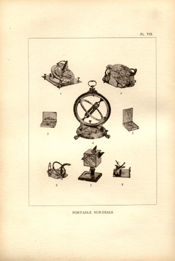
[Full Image]
PORTABLE SUN-DIALS.

[Full Image]
DIAL FROM HERCULANEUM (SCALE 2/3).
PORTABLE SUN-DIALS
ALTHOUGH everyone knows that sundials are often to be seen on the walls of churches or on stone pedestals in old gardens, and though we all understand that such dials were the immediate ancestors of our public clocks, still there are comparatively few who know any members of the younger branch of the family, namely, the pocket dials, the rude forefathers of the modern watch. And it will probably be a surprise to most people to learn how many have been the varieties and how protean the forms of the portable dials that were used in various ages and countries, and what a vast amount of time and thought was expended on their design and construction.
There is no doubt that fixed dials preceded portable ones by many ages, and that the length of his own shadow long continued to be the only visible timekeeper that a man carried about with him, and one that was in recognized use in classical times (see p. 6) to which period the earliest known specimen of a portable dial must also be ascribed. This dial, which is made in the shape of a ham, was found in excavations at Herculaneum in 1754, and is now in the Naples museum, where Miss Lloyd made the drawing from which the illustration is taken.
Its material is bronze, and on its flat side are vertical lines enclosing six spaces, below which are engraved the shortened names of the months, with the winter months under the shortest space and the
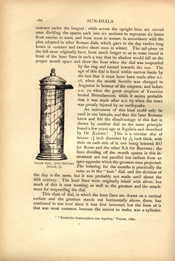
[Full Image]
PILLAR DIAL, 17TH CENTURY (SCALE, 1/1).
summer under the longest; while across the upright lines are curved ones dividing the spaces each into six sections to represent six hours from sunrise to noon, and from noon to sunset, in accordance with the plan adopted in other Roman dials, which gave to the day twelve long hours in summer and twelve short ones in winter. The tail-piece on the left must originally have been much longer so as to come round in front of the hour lines in such a way that its shadow would fall on the proper month space and show the hour when the dial was suspended by the ring and turned towards the sun. The age of this dial is fixed within narrow limits by the fact that it must have been made after B.C. 28, when the month Sextilis was changed to Augustus in honour of the emperor, and before A.D. 79 when the great eruption of Vesuvius buried Herculaneum, while it seems probable that it was made after A.D. 63 when the town was greatly injured by an earthquake.
An instrument of this kind could only be used in one latitude, and that the later Romans knew and felt the disadvantage of this fact is shown by another dial on the same principle found a few years ago at Aquileia and described by Dr. Kenner. 1 This is a circular disc of bronze 1 1/4 inch diameter by 5/16 inch thick, with dials on each side of it, one being lettered RO for Rome, and the other RA for Ravenna; the lines dividing off the month spaces in this instrument are not parallel but radiate from an apex opposite which the gnomon once projected. The lettering for the months is practically the same as in the "ham" dial, and the division of the day is the same, but it was probably not made until about the fifth century. The hour lines were originally inlaid with silver, but much of this is now wanting, as well as the gnomon and the attachment for suspending the dial.
This class of dial, in which the hour lines are drawn on a vertical surface and gnomon stands out horizontally above them, has continued in use ever since it was first invented, but the form of it that was most common, because the easiest to make, was a cylinder,
1 "Römische Sonnenuhren aus Aquileia," Vienna, 1880.

[Full Image]
MODERN PYRENEAN DIAL (SCALE, 2/3).
the "Kalendar," or "Chilindre" on which treatises are extant written in this country as early as the thirteenth century. 1
These dials, also called "column," "pillar," or "Shepherds' dials," were small cylinders of wood or ivory, having at the top a kind of stopper with a hinged gnomon in it. When in use this stopper had to be taken out and replaced with the gnomon turned out and projecting over the proper month space, or line; then, when the dial was allowed to hang vertically with the pointer towards the sun, a shadow fell on the curved hour lines and gave the time. The accompanying illustrations show two dials of this kind, one of the type used in the sixteenth centuries and seventeenth centuries in all parts of Europe, and the other dial as now used in the Pyrenees.
A dial of this type adapted to a walking-stick is to be seen in the Ashmolean Museum, Oxford, and another made by Edmund Culpepper (1666 to 1706), which forms also a telescope, belongs to Albert Hartshorne, Esq., F.S.A. The same type, but in an exaggerated form, is used by the Indian pilgrims, who carry staves 4 feet 6 inches to 5 feet 6 inches long with dials on them when making pilgrimage to Benares. An account of one of these, translated from the "Deutsche Uhrmacher Zeitung," was given in the "Horological Journal" for January, 1899, which seems to agree with a specimen now in the British Museum and with one in my collection, except that the writer ascribes to it the fabulous age of "about two thousand years." "Ashadah" is given as the name of these staves after the month of that name — from the middle of June to the middle of July — in which pilgrimages to Benares usually commenced, and they seem to have been made in the country about Bhutan and Eastern Nepal. The staves are octagonal with divisions and numerals carved on each side to show the number of half hours from sunrise or sunset; four of the sides having each to serve for two months. The gnomon, a small stick or wire, is carried in a hollow down the centre of the staff, and when in use is placed in the transverse hole above the hour lines for the month.
Other modifications of this class of dial are given in the illustrations,
1 "Chaucer Society Publications," second series, No. 2, Part I., and No. 9, Part II.
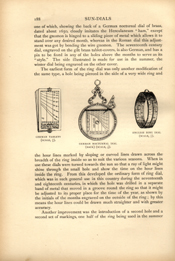
[Full Image]
GERMAN TABLETS (SCALE, ½).
GERMAN NOCTURNAL DIAL (BACK) (SCALE, ½).
ENGLISH RING DIAL (SCALE, 1/1).
one of which, showing the back of a German nocturnal dial of brass, dated about 1650, closely imitates the Herculaneum "ham," except that the gnomon is hinged to a sliding piece of metal which allows it to stand over any desired month, whereas in the Roman dial this adjustment was got by bending the wire gnomon. The seventeenth century dial, engraved on the gilt brass table-covers, is also German, and has a pin to be fixed in any of the holes above the months to serve as its "style." The side illustrated is made for use in the summer, the winter dial being engraved on the other cover.
The earliest form of the ring dial was only another modification of the same type, a hole being pierced in the side of a very wide ring and the hour lines marked by sloping or curved lines drawn across the breadth of the ring inside so as to suit the various seasons. When in use these dials were turned towards the sun so that a ray of light might shine through the small hole and show the time on the hour lines inside the ring. From this developed the ordinary form of ring dial, which was in such general use in this country during the seventeenth and eighteenth centuries, in which the hole was drilled in a separate band of metal that moved in a groove round the ring so that it might be adjusted to its proper place for the time of the year, as shown by the initials of the months engraved on the outside of the ring; by this means the hour lines could be drawn much straighter and with greater accuracy.
Another improvement was the introduction of a second hole and a second set of markings, one half of the ring being used in the summer
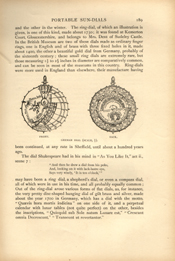
[Full Image]
FRONT. BACK.
GERMAN DIAL (SCALE, 2/3).
and the other in the winter. The ring-dial, of which an illustration is given, is one of this kind, made about 1730; it was found at Kemerton Court, Gloucestershire, and belongs to Mrs. Dent of Sudeley Castle. In the British Museum are two of these dials made as ordinary finger rings, one is English and of brass with three fixed holes in it, made about 1400, the other a beautiful gold dial from Germany, probably of the sixteenth century; these small ring dials are extremely rare, but those measuring 1 ½ to 2 ½ inches in diameter are comparatively common, and can be seen in most of the museums in this country. Ring-dials were more used in England than elsewhere, their manufacture having been continued, at any rate in Sheffield, until about a hundred years ago.
The dial Shakespeare had in mind in "As You Like It," act ii., scene 7:
"And then he drew a dial from his poke,
And, looking on it with lack-lustre eye,
Says very wisely, 'It is ten o'clock,' "
may have been a ring dial, a shepherd's dial, or even a compass dial, all of which were in use in his time, and all probably equally common; Out of the ring-dial arose various forms of flat dials, as for instance, the very pretty disc-shaped hanging dial of gilt brass and silver, made about the year 1700 in Germany, which has a dial with the motto, "Quævis hora mortis indicina" on one side of it, and a perpetual calendar with lunar tables (not quite perfect) on the other, besides the inscriptions, "Quicquid sub Sole natum Lunare est." "Crescunt omnia Decrescunt." "Transeunt ut revertantur."
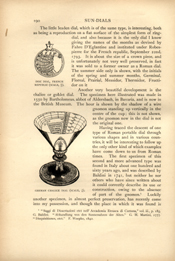
[Full Image]
DISC DIAL, FRENCH REPUBLIC (SCALE, 2/3).
GERMAN CHALICE DIAL (SCALE, ½).
The little leaden dial, which is of the same type, is interesting, both as being a reproduction on a flat surface of the simplest form of ring-dial, and also because it is the only dial I know giving the names of the months as devised by Fabre D'Eglantine and instituted under Robespierre for the French republic, September 22nd, 1793. It is about the size of a crown piece, and is unfortunately not very well preserved, in fact it was sold to a former owner as a Roman dial. The summer side only is shown, with the initials of the spring and summer months, Germinal, Floreal, Prairial, Messidor, Thermidor, Fructidor on it
Another very beautiful development is the chalice or goblet dial. The specimen here illustrated was made in 1550 by Bartholomeus, abbot of Aldersbach, in Bavaria, and is now in the British Museum. The hour is shown by the shadow of a wire gnomon standing up vertically in the centre of the cup; this is not shown, as the gnomon now in the dial is not the original one.
Having traced the descent of one type of Roman portable dial through various shapes and in various countries, it will be interesting to follow up the only other kind of which examples have come down to us from Roman times. The first specimen of this second and more advanced type was found in Italy about one hundred and sixty years ago, and was described by Baldini in 1741, but neither he nor others who have since written about it could correctly describe its use or construction, owing to the absence of part of the gnomon.1 Luckily another specimen, in almost perfect preservation, has recently come into my possession, and though the place in which it was found is
1 "Saggi di Dissertazioni, etct nell' Accademia Etrusca di Cortona," vol. iii., p. 185. G. Baldini. "Abhandlung von den Sonnenuhren der Alten." G. H. Martini, 1777. "Disquisitiones, etct." F. Woepke, 1842.
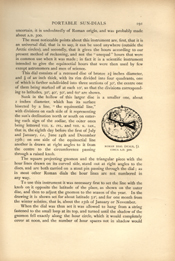
[Full Image]
ROMAN DIAL (SCALE, 2/3).
CIRCA A.D. 300.
uncertain, it is undoubtedly of Roman origin, and was probably made about A.D. 300.
The most noticeable points about this instrument are, first, that it is an universal dial, that is to say, it can be used anywhere (outside the Arctic circles), and secondly, that it give the hours according to our present method of reckoning, and not the "unequal" hours that were in common use when it was made; in fact it is a scientific instrument intended to give the equinoctial hours that were then used by few except astronomers and men of science.
This dial consists of a recessed disc of bronze 2 3/8 inches diameter, and 1/8 of an inch thick, with its rim divided into four quadrants, one of which is farther subdivided into three sections of 30°, the centre one of them being marked off at each 10°, so that the divisions corresponding to latitudes, 30°, 40°, 50°, and 60° are shown.
Sunk in the hollow of this larger disc is a smaller one, about 2 inches diameter, which has its surface bisected by a line, "the equinoctial line," with divisions on each side of it representing the sun's declination north or south on entering each sign of the zodiac, the outer ones being lettered VIII. K. IVL. and VIII. K. IAN., that is, the eighth day before the first of July and January, i.e., June 24th and December 25th; on one side of the equinoctial line another is drawn at right angles to it from the centre to the circumference passing through a raised knob.
The square projecting gnomon and the triangular piece with the hour lines drawn on its curved side, stand out at right angles to the discs, and are both carried on a stout pin passing through the dial; as in most other Roman dials the hour lines are not numbered in any way.
To use this instrument it was necessary first to set the line with the knob on it opposite the latitude of the place, as shown on the outer disc, and then to adjust the gnomon to the season of the year. In the drawing it is shown set for the latitude 52°, and for one month from the winter solstice, that is, about the 25th of January or November.
When the dial was thus set it was allowed to hang from a string fastened to the small loop at its top, and turned until the shadow of the gnomon fell exactly along the hour circle, which it would completely cover at noon, and the number of hour spaces not in shadow would
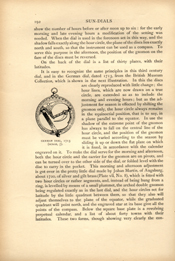
[Full Image]
GERMAN DIAL, 1713 (SCALE, ½).
show the number of hours before or after noon up to six: for the early morning and late evening hours a modification of the setting was needed. When the dial is used in the forenoon set in this way, and the shadow falls exactly along the hour circle, the plane of the discs lies exactly north and south, so that the instrument can be used as a compass. To serve this purpose in the afternoon, the position of the gnomon on the face of the discs must be reversed.
On the back of the dial is a list of thirty places, with their latitudes.
It is easy to recognize the same principles in this third century dial, and in the German dial, dated 1713, from the British Museum Collection, which is shown in the next illustration. In this the discs are clearly reproduced with little change; the hour lines, which are now drawn on a true circle, are extended so as to include the morning and evening hours; but as the adjustment for season is effected by shifting the gnomon only, the hour circle always remains in the equinoctial position, that is to say, in a plane parallel to the equator. In use the shadow of the extreme point of the gnomon has always to fall on the central line of the hour circle, and the position of the gnomon must be varied according to the season by sliding it up or down the flat plate on which it is fixed, in accordance with the calendar engraved on it. To make the dial serve for the morning and afternoon, both the hour circle and the carrier for the gnomon are on pivots, and can be turned over to the other side of the dial or folded level with the disc to carry in the pocket. This morning and afternoon adjustment is got over in the pretty little dial made by Johan Martin, of Augsburg, about 1720, of silver and gilt brass (Plate vii, No. 8), which is fitted with two hour circles or rather segments, and, instead of being hung from a ring, is levelled by means of a small plummet, the arched double gnomon being regulated exactly as in the last dial, and the hour circles set for latitude by the little quadrant between them, so that they also will adjust themselves to the plane of the equator, while the graduated quadrant will point north, and the engraved star at its base give all the points of the compass. Below the square base plate is a revolving perpetual calendar, and a list of about forty towns with their latitudes. These two forms, though showing very clearly the con-

[Full Image]
ENGLISH UNIVERSAL RING DIAL, CIRCA 1620 (SCALE, 4/5).
nection between Roman and recent dials, are much less often met with than the "universal ring dial," which was a kind of armillary sphere constructed on similar principles to these dials, and was in general use over Europe from the beginning of the sixteenth century. The one shown in the illustration was made by Elias Allen, of London, about 1620. In this dial a spot of sunlight falling on the central line of the hour circle, shows the time, the gnomon being a small hole in a sliding piece of brass, which has to be set according to the season. When in use the outer circle will represent a meridian circle; the hour ring, the equator; and the slotted plate in which the gnomon slides, the pole. These universal ring dials were sometimes furnished with sights, and mounted for use as levels or surveying instruments, as in the dial made by J. Heath about 1740 (Plate vii, No. 4), which is 15 inches high, and has a large compass in the base, with two spirit levels let into it, and three leveling screws in the feet. The instrument shown on the same plate (No. 2) is designed on the same lines as the last two dials, the ornamented plate with the toothed wheel round its edge has to be sloped more or less according to the latitude, and when in use lies parallel to the equatorial plane, while the small arm, with the perforated sights on it, has to be shifted to suit the sun's declination by means of the calendar at its northern end, the hour being shown by the pointer just below this, and the minute on the clock face opposite by means of the little hand which is attached to, and turns with, a pinion geared into the toothed edge of the main dial plate.
There are other forms of dial in which the principal circles of the sphere are projected on a plane, instead of being reproduced in metal rings or bands, as was attempted in the dials last described. The

[Full Image]
QUADRANT MADE FOR RICHARD II. (SCALE, 2/3).
English quadrant, shown in the illustration, is an early specimen of this class of dial. It is made of brass, and has on it the badge of King Richard II., and the date 1399, the last year of his reign, and is now in the British Museum. In this and other quadrant dials the time is shown by a bead, which can be moved up and down a plumb-line hanging from the centre of the quadrant, the bead being adjusted to the day of the month, in the calendar on the edge of the quadrant, and placed at the point where the day-line crosses the twelve o'clock line; then the sun's altitude is taken by means of the pierced sights on the quadrant, and the hour is shown by the position of the bead on the hour-lines. There were many varieties of these quadrants, some of which were in use up to the end of the last century even in this country.
The dial, in the shape of an ancient ship with turrets at each end, which was probably made in Germany at the end of the fifteenth century, has also a bead on a plumb-line to show the time, but it is an universal dial. The slider on the mast, to which the plumb-line is fastened, has to be raised or lowered according to the latitude, and the rake of the mast set, according to the time of the year, by means of the calendar near the bottom of the ship, and the bead duly placed in position on the thread, after which, if the sun's height is taken by the sights in the two turrets, the bead will show the time as in the quadrant dials. The same dial was sometimes drawn on a plain surface, the thread being fastened to the end of a jointed arm which could be adjusted for latitude and season by its position on a series of graduated
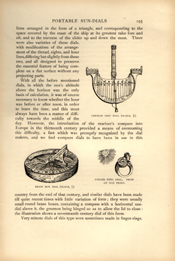
[Full Image]
GERMAN SHIP-DIAL (SCALE, 2/3).
BRASS BOX DIAL (SCALE, 1/1).
FINGER RING DIAL. FROM AN OLD PRINT.
lines arranged in the form of a triangle, and corresponding to the space covered by the mast of the ship at its greatest rake fore and aft, and to the traverse of the slider up and down the mast. There were also varieties of these dials, with modifications of the arrangement of the thread, sights, and hour lines, differing but slightly from these two, and all designed to preserve the essential feature of being complete on a flat surface without any projecting parts.
With all the before mentioned dials, in which the sun's altitude above the horizon was the only basis of calculation, it was of course necessary to know whether the hour was before or after noon, in order to learn the time, and this must always have been a matter of difficulty towards the middle of the day. However, the introduction of the mariner's compass into Europe in the thirteenth century provided a means of overcoming this difficulty, a fact which was promptly recognized by the dial makers, and we find compass dials to have been in use in this country from the end of that century, and similar dials have been made till quite recent times with little variation of form; they were usually small round brass boxes, containing a compass with a horizontal sun-dial above it, the gnomon being hinged so as to allow the lid to close: the illustration shows a seventeenth century dial of this form.
Very minute dials of this type were sometimes made in finger-rings,
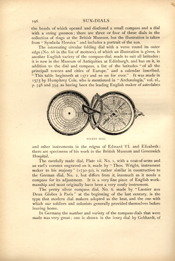
[Full Image]
POCKET DIAL.
the bezels of which opened and disclosed a small compass and a dial with a string gnomon; there are three or four of these dials in the collection of rings at the British Museum, but the illustration is taken from "Symbola Heroica" and includes a portrait of the sun.
The interesting circular folding dial with a verse round its outer edge (No. 68 in the list of mottoes), of which an illustration is given, is another English variety of the compass-dial, made to suit all latitudes; it is now in the Museum of Antiquities at Edinburgh, and has on it, in addition to the dial and compass, a list of the latitudes "of all the principall townes and cities of Europe," and a calendar inscribed, "This table beginneth at 1572 and so on for ever." It was made in 1575 by Humphrey Cole, who is mentioned in "Archæologia," vol. xl., p. 348 and 354, as having been the leading English make of astrolabes, and other instruments in the reigns of Edward VI. and Elizabeth; there are specimens of his work in the British Museum and Greenwich Hospital.
The carefully made dial, Plate vii, No. 1, with a coat-of-arms and an earl's coronet engraved on it, made by "Thos. Wright, instrument maker to his majesty" (1730-50), is rather similar in construction to the German dial, No. 2, but differs from it, inasmuch as it needs a compass for its adjustment. It is a very fine piece of English workmanship and must originally have been a very costly instrument.
The pretty silver compass dial, No. 6, made by "Lasnier aux Deux Globes à Paris" at the beginning of the last century, is the type that modern dial makers adopted as the best, and the one with which our soldiers and colonists generally provided themselves before leaving home.
In Germany the number and variety of the compass-dials that were made was very great; one is shown in the ivory dial by Gebhardt, of

[Full Image]
NUREMBERG DIAL AND COMPASS (SCALE, ½).
GERMAN METAL FOLDING DIAL (SCALE, 2/3).
Nuremberg, dated 1561, in which a thread forms the gnomon. It is a type that was to some extent used in all countries, but which was an especial favourite in Germany, and the ivory dial by Hans Troschel about 1640, Plate vii, No. 3, with the motto, "Hora fugit mors venit," on it, is one of a similar class; when closed it takes the form of a book 3 1/4 inches by 2 3/8 inches in measurement. No. 5 on the same plate shows another ivory dial by the same maker.
The metal folding dial, 2 ½ inches by 2 inches, made by V.S. (probably Ulric Schneip, of Munich) is another form of the same dial that was popular at the end of the sixteenth century.
Plate vii, No. 7, shows a cube with five dials on it which is supported by a hinged leg standing on an oblong base with a compass in it. This instrument illustrates one of the commonest forms of a type of dial that can be set in the true position without the use of a compass, and which derives this property from the fact that if a series of dials for one and the same latitude are drawn on several sides of a solid body, the dials will be standing in their true position when they all show the same hour. This individual German dial can be set to suit various latitudes by means of a plumb-line and graduated quadrant on one of its sides, but most dials of the type are only suited to one latitude and have no compass attached to them. Besides the varieties of German dials which I have described, there were a great many others in use which, together with the numerous books on the subject published in Germany, show that the art of dialing was more closely followed there than in any other part of Europe. The French dial makers, however, were not far behind in the variety of their patterns,

[Full Image]
FRENCH SILVER DIAL (SCALE, 2/3).
ITALIAN DISC DIAL (SCALE, ½).
CRUCIFIX DIAL (SCALE, ½).
whilst their workmanship, at any rate in the eighteenth century, was only inferior to that of the best English makers. The French ivory dials made by Bloud, of Dieppe, and others towards the end of the seventeenth century, were followed by metal instruments like the enamelled silver dial made by Macquart, of Paris, about one hundred and sixty years ago, of which there is an illustration. Dials of this class were generally made with shagreen or fish skin cases to protect them when carried about, the "bird" style being folded down flat with the dial-plate when in the case, and they furnish some of the prettiest examples of portable dials that are to met with.
Two forms of dial are peculiar to Italy, the disc dials of gilt brass with the Italian hours (reckoned from sunset) marked on them, which were made in Rome towards the end of the sixteenth century. The dial shown is dated 1585, it has a sun-dial on each side of the disc, and the compass is pivoted so as to turn over and serve for both dials; in some specimens there are several dials for different latitudes drawn on each side of the disc. The gnomons are little upright pins or pegs, and the arrangement of the hour lines differ in a notable way from that on the dials previously described. This type of dial continued to be made of both brass and wood, usually in flat round boxes, until the beginning of this century.
The other form of dial, which is almost confined to Italy, and which is but rarely to be met with even there, is the cross-shaped dial containing a reliquary. In this dial the cross is sloped in accordance with the latitude by means of graduations on the lower part of the dial; it is then set north and south by aid of the small compass, and the shadow
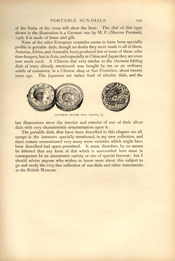
[Full Image]
JAPANESE SILVER DIAL (SCALE, ½).
of the limbs of the cross will show the hour. The dial of this type shown in the illustration is a German one by M.P. (Marcus Purman), 1596, it is made of brass and gilt.
None of the other European countries seems to have been specially prolific in portable dials, though no doubt they were made in all of them. America, Africa, and Australia have produced few or none of these solar time-keepers, but in Asia, and especially in China and Japan they are even now much used. A Chinese dial very similar to the German folding dials of ivory already mentioned was bought by me as an ordinary article of commerce, in a Chinese shop at San Francisco, about twenty years ago. The Japanese are rather fond of circular dials, and the last illustrations show the interior and exterior of one of their silver dials with very characteristic ornamentation upon it.
The portable dials that have been described in this chapter are all, except in the instances specially mentioned, in my own collection, and there remain unmentioned very many more varieties which might have been described had space permitted. It must, therefore, by no means be inferred that any form of dial which is unrecorded here must in consequence be an uncommon variety or one of special interest; but I should advise anyone who wishes to know more about this subject to go and study the very fine collection of sun-dials and other instruments at the British Museum.

